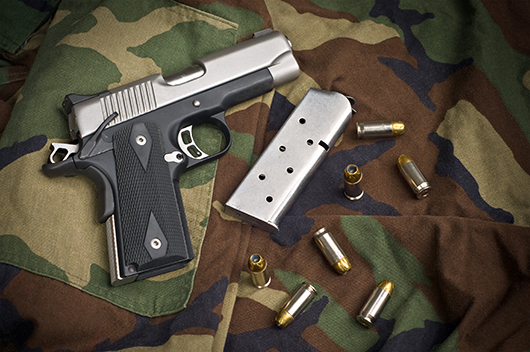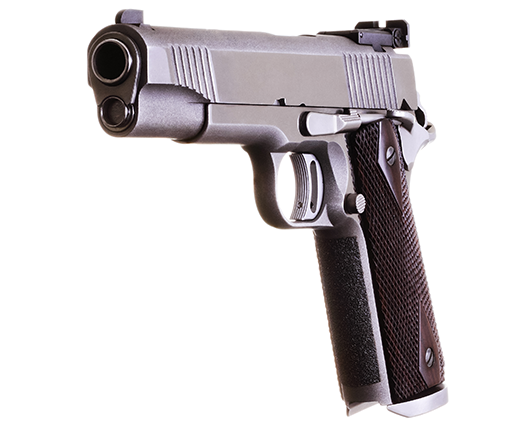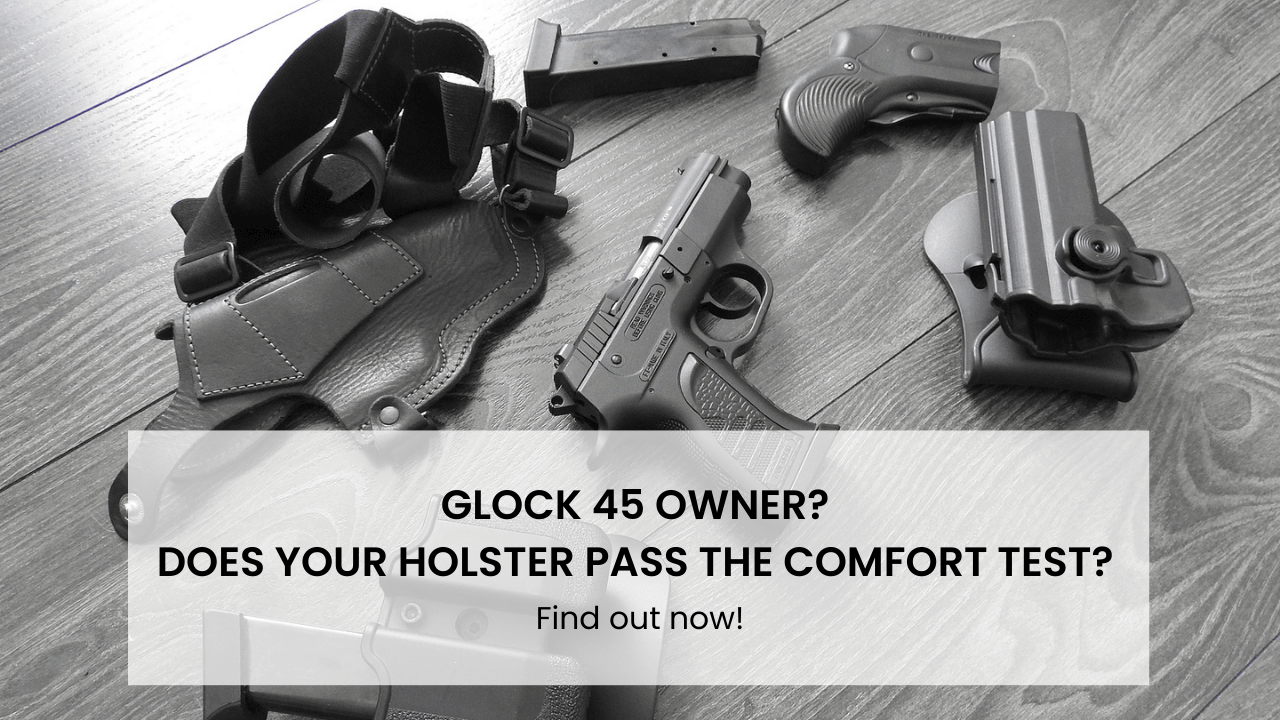How to Choose the Best Colt 1911 Holster
Feb 22nd 2021

When you buy a handgun for self-defense, you have to decide where this gun will spend most of its time regardless of the model. Do you keep it on the nightstand, in a drawer, in your car’s glove compartment, or with you? If your Colt 1911 model is for home defense, then the type of holster that’s best for you is less important. If, however, you want to carry your 1911, then the gun holster you choose can mean the difference between life and death, winning and losing.
Colt 1911
The famous 1911 handgun is the work of legendary firearms designer John Browning in cooperation with Colt’s technical staff. Single-action-only (SAO), hammer-fired, locked-breech, and recoil-operated, the 1911 is the oldest semi-automatic pistol design still in regular use. Originally chambered in .45 ACP (Automatic Colt Pistol), 1911-pattern handguns are available in a variety of cartridges, from the diminutive .22 Long Rifle to the big-bore .50 Guncrafter Industries.
As a single-action handgun, the 1911 is customarily carried in Condition One or “cocked and locked.” In this condition of readiness, the pistol has a round in the chamber, a full magazine in place, a cocked hammer, and the manual safety lever engaged. When you draw the pistol, you disengage the manual safety with your thumb.
A feature that many 1911 pistols have is a grip safety. Many gunsmiths and competitive shooters regard the grip safety as superfluous, but a modern alteration is the upswept beavertail with memory bump. This design virtually eliminates the risk of hammer bite while also ensuring that the safety will be activated with a less-than-ideal firing grip.
1911 Pistol Variants

The 1911 is available in several configurations to meet specific demands. These include:
- Government Model: The original full-sized M1911A1 or Series 70 handgun is the pistol carried in WWI, WWII, Korea, and Vietnam
- Commander: Introduced in 1950, the Commander is a compact variant of the M1911A1, substituting a 4.25” barrel and an aluminum-alloy frame for the 5” barrel and steel frame of the Government Model. Commander-type pistols are available in 9mm, .45 ACP, and .38 Super.
- Officer’s ACP: This can be considered a subcompact. Featuring a 3.5” barrel, the Officer’s ACP is ideal for concealment.
- Longslide: While the Government Model has a 5” barrel, some shooters and manufacturers have sought to increase both the barrel length and slide to 6” or 7” to increase muzzle velocity and the sight radius.
What Factors Matter in a Holster
Before you decide what type of holster to purchase, what material it should be made from, it’s essential that you understand what the criteria are for a holster to meet.
- Retention: Retention refers to the property of the holster to keep your firearm secure. This serves two purposes. First, when you carry your firearm, you need to know that it won’t fall out. If you have to run down the street to catch a bus, for example, you need to know that your firearm will remain secure. Second, retention affects the draw stroke. The looser the retention, the more potentially difficult it is for you to draw your weapon — at the same time, it’s also more difficult for an assailant to disarm you
- Safety: Unintentional discharges are preventable most of the time by strictly observing firearms-safety rules. However, some holster designs are more conducive to safe firearms handling than others. As a result, the ideal holster should cover the trigger guard entirely. When you place your strong hand on the weapon and achieve a full firing grip, your index finger should remain straight alongside the holster, and the trigger guard, as you draw the weapon.
- Accessibility: This can be related to retention and safety, depending on how these factors overlap or complement each other. Accessibility can also be considered a synonym for speed — how easily and quickly can you draw your weapon when your life depends on it? When re-holstering your pistol, can you do so with one hand?
- Concealability: How concealable a holster is will depend on several factors. If you intend to carry your weapon openly, then this is a moot point. However, some holster designs are more applicable to deep concealment than others are.
- Comfort: An often overlooked or dismissed criterion is comfort. The notion that carrying a concealed firearm shouldn’t be comfortable is commonplace but dubious. If your holster is uncomfortable, you’ll be less likely to wear it.
- Adjustability: Your ability to adjust the holster’s position, how it cants the gun, and how snugly it retains it will allow you to tailor the draw, comfort, and concealability to suit your particular requirements.
- Durability: This quality affects how well the holster can stand up to rough handling and adverse weather and how well it maintains its shape. A holster that is susceptible to deformation, especially of the holster mouth, can render one-handed reholstering difficult. If the holster mouth isn’t rigid and closes, you’ll need to use your support hand to open it.
Specific Holster Features
- Locking mechanisms: Some holsters have an active retention system consisting of a mechanism that locks inside the trigger guard and requires you to depress a button or manipulate a lever with your index finger or thumb to unlock the pistol. When selecting a holster with an active-retention system, you should always ensure that it doesn’t require you to bend or curl your finger in such a way that it would enter the trigger guard of the pistol as you draw it.
- Thumb break: A type of retention strap, the thumb break is often found on leather holsters and uses a snap closure. This can reduce your speed on the draw, but it also means that your weapon will be harder to take from you.
- Retention screws: Another type of retention is passive, which relies on friction and intricate molding to ensure a snug fit. If retention is adjustable, it will be in the form of screws that will grip the pistol more or less when tightened or loosened.
- Sweat guard: Also called a sweat shield, this is the part of the holster that’s raised to cover the slide of a semi-automatic pistol, keeping it from pressing against your body. This both protects the gun against perspiration and your skin against hot, cold, or charging serrations (grasping grooves).
- Open top: For a fast draw, an open-top holster enables you to clear the holster without having to move any straps or over-flaps out of the way. This is one of the most common holster types.
How to Carry?
How you should carry your handgun is a very personal matter. First, let’s take a look at how carry positions are described. A common way of describing waistband carry positions is to use a clock face metaphor. Imagine that your waistline is a clock. Your navel is at 12 o’clock, your right and left hips at 3 and 9 o’clock, respectively, and the small of your back is at 6.
How you decide you’d like to carry your handgun will depend on several factors, such as how you dress, whether you’re sedentary or physically active, the climate, and whether you have any physical disabilities. Some of the most common waistband carry positions include the following:
- Strong side: This is by far the most popular choice of waistband carry position. Your strong side is on or behind the hip that corresponds to your dominant or strong hand. If you’re right-handed, your strong side is your right hip — 3 o’clock. If you’re a southpaw, it’s your left hip — 9 o’clock. One of the advantages of the strong-side position is that it allows you to keep your firearm as far away from an assailant as possible. Unfortunately, drawing your weapon while sitting, such as in a vehicle, can be a challenge, especially if you also have to navigate the seatbelt
- Cross draw: Carrying your pistol butt forward on the side of your body opposite to your strong hand, this carry method can be less strenuous on the strong-side arm in individuals with shoulder injuries. It can also enable a very fast draw stroke.
- Appendix: One of the fastest positions is 12 or 1 o’clock — appendix carry. If you also carry IWB, it’s also one of the most concealable. However, appendix carry is also controversial because the risk of death or serious injury from an unintentional discharge is magnified due to the direction in which the muzzle is pointed.
- Small of back: Carrying your gun in the small of your back places it at the 6 o’clock position — the opposite of appendix. Some gun owners express concern that having the firearm pressed against your vertebrae is a safety hazard, especially if you fall rearward. That’s a calculated risk. The small of the back position lets you carry your firearm.
Waistband Holster Carry Methods — IWB and OWB
When choosing a waistband holster for concealed carry, there are two methods of carry that you can choose from. These are:
- IWB: Inside the waistband or IWB holsters use belt clips or another mounting system to allow you to wear your holster between the body and the waistband. This method is popular among those who require deep concealment.
- OWB: Outside the waistband or OWB holsters attach to the belt outside of the pants. While this method is concealable with a cover garment, such as a jacket or coat, it’s especially useful for open carry.
Paddle Holster or Pancake Holster?
Similar sounding, these holsters are quite different from each other. A paddle holster is about convenience. The holster doesn’t attach to a belt with loops or clips, instead relying on a flat piece of plastic or leather to hold it in place. While not as secure as its attachment uses friction, it’s one of the easiest types to remove.
On the other hand, a pancake holster consists of the holster pocket and a backing made from leather or synthetic, which usually uses belt loops to attach. The gun is held between these two parts and close to the body for increased concealment.
Non-Waistband Carry Methods
If you determine that carrying your Colt 1911 in a waistband holster is not appropriate for your needs, there are other options available.
- Shoulder Holster: A classic non-waistband option is to carry your firearm in a shoulder holster, which uses a harness. You may see this type of holster and think that only police detectives and bodyguards wear shoulder holsters, but it can be highly useful for individuals
- Thigh holster: If you wear loose-fitting clothings — sportswear, dresses, skirts, etc. — a thigh holster allows you to carry a handgun attached to your leg without relying on a belt. This type often uses an elastic band with Velcro closure to wrap the gun securely around your leg.
- Drop-leg holster: This is the holster most commonly associated with the American Old West’s gunslingers and lawmen. However, while suitable for quick-draw and Cowboy Action shooting competitions, the drop-leg holster also has tactical applications. While not suitable for concealment — unless you’re wearing an overcoat — the drop-leg holster provides both accessibility and a fast draw.
- Ankle Holster: If you carry a compact or subcompact handgun as a backup, such as an Officer’s ACP, the ankle holster can be a convenient and highly concealable option. You should be aware, however, that the ankle holster is not suitable for full-size service handguns. If you need to quickly gain access to your firearm, this can also be a disadvantage relative to alternatives.
Off Body Carry
There are circumstances under which you can’t carry a handgun on your person. While this is less than ideal, it’s sometimes unavoidable. If, for example, you live in a jurisdiction where carrying a firearm is prohibited or heavily restricted, but keeping a gun in your vehicle is not, that may be the only viable option available to you. Likewise, if you’re wheelchair-bound or otherwise physically disabled, you may find that it’s more convenient for you to keep your firearm in an off-body location.
Holster Materials
Holsters are available in a variety of materials to suit different tastes and applications. The most popular, however, are leather and Kydex.
- Leather: The original holster material — tanned animal skins. Prized by shooters for its fit, feel, and styling, leather molds to the body over time. However, leather is more susceptible to absorbing moisture and deforming than modern synthetic materials.
- Kydex: An impact- and crush-resistant thermoplastic, Kydex has risen in popularity over the years to become one of the leading holster materials. Kydex holsters are less susceptible to deformation, which is important when re-holstering your firearm. It also means that you won’t have to open the holster mouth with your support hand, potentially covering your hand with the muzzle.
Magazine Carriers
Also called magazine pouches, these provide you with one or two additional magazines for your carry gun. When wearing a waistband holster, you usually place magazine carriers on the side opposite to your holster, retrieving a replacement with your support hand as you drop the empty magazine with your strong.
In Conclusion
If you intend to carry a handgun for self-defense, whether openly or concealed, your choice of holster is critical. You should be aware of several criteria when selecting a holster to suit your carry needs.
At Incognito Concealment, we take pride in helping gun owners — new, experienced, and prospective — make an informed decision that suits them. Call us at (586) 999-5820 — we’d be happy to guide you through the process.











